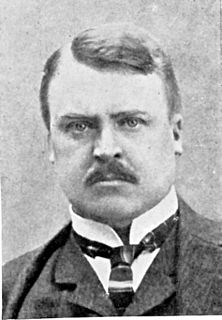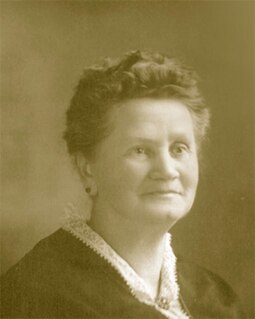
In philosophy, empiricism is a theory that states that knowledge comes only or primarily from sensory experience. It is one of several views of epistemology, along with rationalism and skepticism. Empiricism emphasizes the role of empirical evidence in the formation of ideas, rather than innate ideas or traditions. However, empiricists may argue that traditions arise due to relations of previous sense experiences.

Jean Louis Rodolphe Agassiz FRS (For) FRSE was a Swiss-born American biologist and geologist who is recognized as a scholar of Earth's natural history.

Ezra Weston Loomis Pound was an expatriate American poet and critic, a major figure in the early modernist poetry movement, and a fascist collaborator in Italy during World War II. His works include Ripostes (1912), Hugh Selwyn Mauberley (1920), and his 800-page epic poem, The Cantos (c. 1917–1962).

How to Read a Book is a 1940 book by the philosopher Mortimer J. Adler. He co-authored a heavily revised edition in 1972 with the editor Charles Van Doren, which gives guidelines for critically reading good and great books of any tradition. The 1972 revision, in addition to the first edition, treats genres, inspectional and syntopical reading.
Empirical evidence for a proposition is evidence, i.e. what supports or counters this proposition, that is constituted by or accessible to sense experience or experimental procedure. Empirical evidence is of central importance to the sciences and plays a role in various other fields, like epistemology and law.
Wilfrid Stalker Sellars was an American philosopher and prominent developer of critical realism, who "revolutionized both the content and the method of philosophy in the United States".

Louis Zukofsky was an American poet. He was one of the founders and the primary theorist of the Objectivist group of poets and thus an important influence on subsequent generations of poets in America and abroad.
The objectivist poets were a loose-knit group of second-generation Modernists who emerged in the 1930s. They were mainly American and were influenced by, among others, Ezra Pound and William Carlos Williams. The basic tenets of objectivist poetics as defined by Louis Zukofsky were to treat the poem as an object, and to emphasize sincerity, intelligence, and the poet's ability to look clearly at the world. While the name of the group is similar to Ayn Rand's school of philosophy, the two movements are not affiliated.
Frank Stuart Flint was an English poet and translator who was a prominent member of the Imagist group. Ford Madox Ford called him "one of the greatest men and one of the beautiful spirits of the country".
"The Death of the Author" is a 1967 essay by the French literary critic and theorist Roland Barthes (1915–1980). Barthes's essay argues against traditional literary criticism's practice of incorporating the intentions and biographical context of an author in an interpretation of a text, and instead argues that writing and creation are unrelated. The essay's first English-language publication was in the American journal Aspen, no. 5–6 in 1967; the French debut was in the magazine Manteia, no. 5 (1968). The essay later appeared in an anthology of Barthes's essays, Image-Music-Text (1977), a book that also included his "From Work to Text".
The Cantos by Ezra Pound is a long, incomplete poem in 116 sections, each of which is a canto. Most of it was written between 1915 and 1962, although much of the early work was abandoned and the early cantos, as finally published, date from 1922 onwards. It is a book-length work, widely considered to be an intense and challenging read. The Cantos is generally considered one of the most significant works of modernist poetry in the 20th century. As in Pound's prose writing, the themes of economics, governance and culture are integral to the work's content.

Samuel Hubbard Scudder was an American entomologist and paleontologist. He was a leading figure in entomology during his lifetime and the founder of insect paleontology in America. In addition to fossil insects, he was an authority on butterflies (Lepidoptera) and grasshoppers (Orthoptera).

Bob Perelman is an American poet, critic, editor, and teacher. He was an early exponent of the Language poets, an avant-garde movement, originating in the 1970s. He has helped shape a "formally adventurous, politically explicit poetic practice in the United States", according to one of his chroniclers. Perelman is professor of English emeritus at the University of Pennsylvania.

Johan Hjort was a Norwegian fisheries scientist, marine zoologist, and oceanographer. He was among the most prominent and influential marine zoologists of his time.
ABC of Reading is a book by the 20th-century Imagist poet Ezra Pound published in 1934. In it, Pound sets out an approach by which one may come to appreciate and understand literature . Despite its title the text can be considered as a guide to writing poetry. The work begins with the "Parable of the sunfish", features a collection of English poetry that Pound called Exhibits and several notable quotations.
"Anekdote zur Senkung der Arbeitsmoral" is a short story by Heinrich Böll about an encounter between an enterprising tourist and a small fisherman, in which the tourist suggests how the fisherman can improve his life. It was written for a May Day programme on the Norddeutscher Rundfunk in 1963, and is considered one of the best stories written by Heinrich Böll.

"The Doctor and the Doctor's Wife" is a short story by Ernest Hemingway, published in the 1925 New York edition of In Our Time, by Boni & Liveright. The story is the second in the collection to feature Nick Adams, Hemingway’s autobiographical alter ego. "The Doctor and the Doctor's Wife" follows "Indian Camp" in the collection, includes elements of the same style and themes, yet is written in counterpoint to the first story.

The Spirit of Romance is a 1910 book of literary criticism by the poet Ezra Pound. It is based on lectures he delivered at the Regent Street Polytechnic in London between 1908 and 1909 and deals with a variety of European literatures. As with Pound's later, unfinished poem The Cantos, the book follows "a pattern, at once historical and atemporal, of cultural beginnings and rebeginnings".

Charlotte Hill (1849–1930) was a homesteader born in Indiana who contributed to paleontology through finding several significant fossil within the Florissant Fossil Beds. She sold many fossils to other collectors and investigators to earn money on the side. Her most significant discovery was the Persephone butterfly near Florissant, Colorado. Charlotte's discoveries brought attention to Florissant as an important location for fossils, and her findings created an impetus for recognition of the fossil beds as a national monument within the United States of America. Many of her collected fossils now reside in the Harvard University museum and the Smithsonian's Museum of Natural History.















